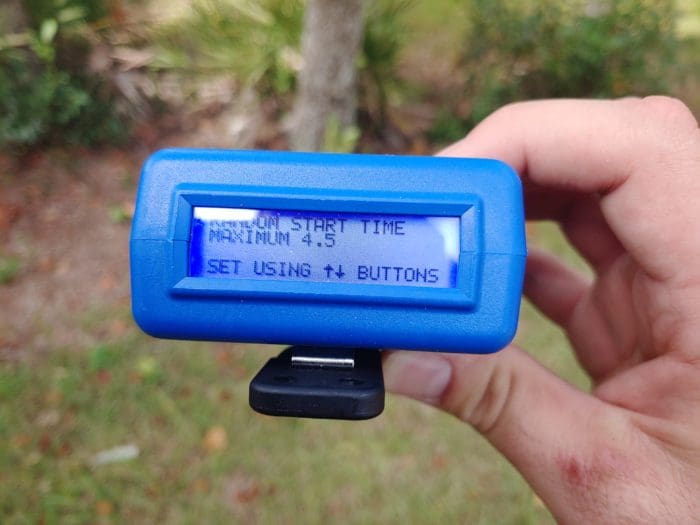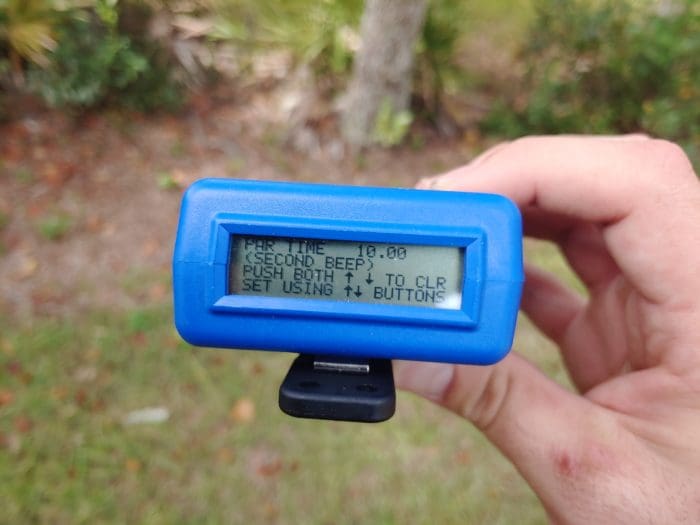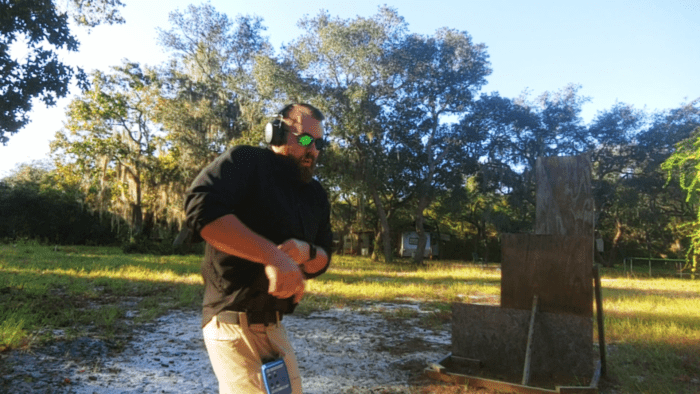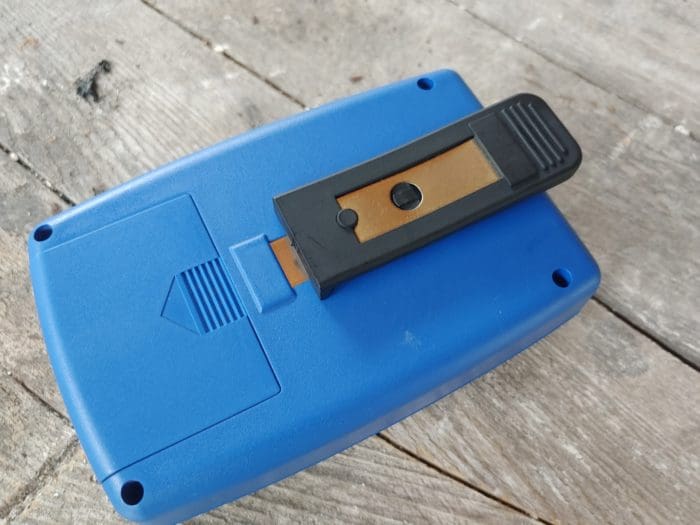I’m not a big fan of the idea that this accessory or that one can make you a better shooter. There are slight performance variances that different gizmos and doohickeys can deliver, for sure. However, if you don’t know how to shoot in the first place, almost none of them are going to help you very much.
One piece of gear I believe can make you a better shooter, though, is a shot timer. I use the Pocket Pro II, but there are a number of different options out there. A shot timer is a device that allows you to measure your times when shooting, and the device can pick up when a shot is fired.

While they are used heavily in 3-Gun, IDPA, USPSA, and other competitions, you can use them for nearly any kind of training. Even if it’s just for the start signal. How does a shot timer improve your shooting?
Timers and Stress
Timers can be set for a delayed start or instant start. Instant is used when you have another person holding the timer. As soon as you hit the go button the timer starts recording.
Delayed start allows the shooter to set a delay in seconds between the go button and the beep. This is perfect when shooting alone; you can hit the button and assume the necessary position prior to shooting, giving yourself a moment before you have to start.

You can also randomize your time setting with the Pocket Pro II to keep you guessing. Mine is set for random and it can go off any time between four and eight seconds after I hit the start button. This randomized setting and the inability to anticipate the beep adds stress. You can measure your skills with the timer and diagnose problem areas with time-based data.
Par Times and Dry Fire
Par times can be set as a countdown timer on the Pocket Pro II and it can work with both instant and delayed shot times. A par timer — a designated start and end interval — can be used for a variety of different training situations.
Par times can also be set when a drill has a strict pass or fail time. For example, the El Presidente drill gives you ten seconds to finish it so I set a par time at 10 seconds and run the drill.

I like the par time function for dry firing. You can set a timer to beep when doing reloads or when drawing. Without shots fired, the traditional recording use of a shot timer isn’t very useful so par time capability is a must-have. As you get faster you can lower the par times and keep getting faster.
Splits
Lastly, the Pocket Pro II can measure your split times. Splits times are the times between shots. Knowing your split times can help you build a cadence while shooting and measure your ability to transition between targets.
Split times are perfect for measuring and diagnosing where you slow down in a drill or in any action shooting sports.

You’d be surprised at the differences in split times when it comes to transitions, especially target transitions at different ranges. Recording and reading your split times on drills like the aforementioned El Presidente can lead you to diagnose where your weaknesses are. If you can diagnose these weaknesses you can fix them and get faster.
The Pocket Pro II
The Pocket Pro II is a tough device and a great shot timer. I’ve been using it for a few months now and its never missed a shot or failed to BEEP when I needed it to.
It does take a little practice and careful reading of the directions to work the settings but once you get the hang of it you won’t have any issues. It saves your settings from the previous use. The buttons are also big and easy to use when wearing gloves. There are only five buttons so once you learn the layout you can use them without even looking.

The Pocket Pro II has a large clip that makes it quick and easy to fit onto a belt or in a pocket. The timer is powered by a 9-volt battery and will last for up to 20 hours on a single cell. The screen is bright enough to read during the brightest of days. The display is big enough for quick and easy reading too.

The only downside is the price. Shot timers tend to be rather expensive, especially considering how simple and low tech they are. The technology really hasn’t changed in decades. However, the Pocket Pro II is a great tool and, to me, it’s well worth the money. It’s made me a better shooter, and that’s well worth it.




Old tech. Use a smart phone shot timer app instead. They are much less expensive and add features the old timers dont have.
I’ve tried them and haven’t found one that is accurate or reliable yet. Do you have one you’d recommend?
I have an Android phone. I use an app called Splits. It doesn’t have a fancy GUI, but it works well–especially when you consider it costs less than a cup of coffee.
Thanks. I had an early version of the splits shot timer and did not like it. I’ll try the new version, it’s a free app.
I use Splits. You can adjust the sensitivity after the fact to accurately record shots.
I like the function of inputting drills that you can refer back to to track improvement, or lack of.
Splits is good.
What timer app do you think is good, because all the ones I ever used were pretty vanilla and a number had issues coping with the built in clipping and noise canceling features of the phones. They also all need you to use headphones to hear them in live fire or have expensive hear pro that can be used as headphones. So not plug friendly, and I’ve never met a set of muffs that didn’t gap when moving around and wearing eyepro. I’d like a quality, feature packed timer app for dry fire though.
On the other hand most of the dedicated timers are garbage in that they have some crippling problem, a few are int he middle. Almost none are good.
The pocket pro II is IMO the best bang for the buck and works the best.
The Pact MK4 if you can find an old one is pretty solid other than having to reseat connections if you dropped it too many times.
For individual use, the ced 7000 and 8000 are ok. For matches the 8000 is too complicated and has horrible ergonomics. The 7000 doesn’t have replaceable cells, and the display becomes unreadable if it gets too hot.
The pact club timer starts failing to pick up shots if it gets too hot.
The pocket pro display becomes unreadable when too hot.
The pact mark IV XP has a nasty bug for competitions where as the buffer gets more and more full, the delay between pressing the button and the beep gets longer and longer and longer. We bought about $3000 worth of them at my club because we had gotten very good use out of the previous gen and liked them. Found the bug, told pact and gave them detailed steps to reproduce it, asked them to fix it, they were basically like FU we don’t care.
Speed timer 3000 has an odd interface and is tough as nails. Not really dry fire drill friendly, and the display goes black in high temps.
Haven’t used a protimer IV, but we had a previous generation mixed in to the pile at the club and the membrane switches + UV exposure did not work out well long term. They all cracked and stopped working.
Honestly for matches, if the practiscore people could figure out how to do it well and just add it to their app, I’d buy a round of drinks for their dev team to celebrate.
I have an Android phone and I use an app called “Splits”. It’s works great. It might take a few adjustments to get it just right for you. You can adjust the sensitivity. I use electronic ear protection, so I don’t have any trouble hearing it go off. For the nominal price that is costs, it works great. I don’t shoot competitively so I can’t comment on how it would perform in that environment.
My buddy is an iPhone guy and he’s tried some iPhone timer apps but he was never able to find a good one.
The problem with cell phone apps isn’t the software, it’s the hardware. A cell phone’s microphone is too sensitive and is overwhelmed by gunfire. With short split times it’s not going to hear both shots. Secondly, a cell phone’s speaker isn’t powerful enough to give you a beep loud enough to be heard through ear protection.
A shot timer and a video camera are invaluable tools for any shooter.
We often think of shot timers as tools for the competitor, but they are for the defensive minded shooter as well.
Mostly because we lie to ourselves, and the timer and camera tell the truth.
How long is it taking you to draw your gun form your pocket holster? Is it really just a second or two, or does it just feel like that? How much does your draw time slow when you are sitting down? What about laying down? Know for real.
Where it really gets humbling is when you start moving. If you are keeping your precision the same, you’ll feel like you are Speedy Gonzalez when walk and fire. The timer will show you just how much you’re really slowing down.
The camera shows your inefficiency, your head position and lack of awareness, and it often shows how often you are muzzling your own body (especially hand and legs) when moving.
If you want to be a better, SAFER, defensive shooter, a timer and a camera will help tremendously.
“A shot timer and a video camera are invaluable tools for any shooter”
Hahaha, you beat me to it.
A shot timer is half of the equation to getting quicker.
The video shows unwanted and/or inefficient movements that increases shot times.
It’s amazing how unaware of bad habits some shooters are, I just spent the past weekend at a friends shooting land (west of Ft Worth Texas) where we did video of timed drills. One shooter had a bad habit of turning his head to the right while dropping it foward (rather than remaining square and erect while bringing the SIGHT PICTURE up and into his natural position). This move was so extreme, he was losing his peripheral vision to the left. He had NO idea of it until he saw video.
I agree that timers are a great training tool. I remember lo those many years ago when I had my first experience with them on a range. It was humbling. A phone app? No thanks. I prefer a stand alone timer. The author mentioned price but didn’t provide it. Any product review is incomplete without MSRP.
Never used a video. Wasn’t that practical in those days. Instead my friend critiqued me. I had the habit of drawing, dropping my arm to full length, then bringing the muzzle to bear on target. This instead of drawing, rotating muzzle to orient muzzle to target as soon as cleared the top of the holster and punch straight out. Proper training works.
The first time I ever watched myself on video moving with a team I cringed the whole time. So did I the 1,000th time.
The Pocket Pro II is manufactured by Competition Electronics in Rockford, Illinois. An American company that stands behind its products (I am not a paid spokesman). They also sell a nice line of chronographs.
https://www.competitionelectronics.com/
In addition to being a great training tool, shot timers are useful for friendly competitions between friends at the range. We do all sorts of timed drills and it’s fun to combine speed and accuracy.
I have their bluetooth equipped pro chrono. Nice chronograph for good price. I just went to their site, but the warning about counterfeit pocket pro II completely covers the screen on my phone, making it unusable for me.
Have a CED 7000 for the last 4 – 5 years. The biggest drawback I’ve found is that simultaneous multiple shooters at an indoor range tend to confuse the timer. When I am shooting solo it works perfectly…great for dry fire practice at home.
Gonna have to give this a try!
Comments are closed.